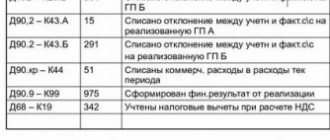Characteristics of an accounting account 58
Account 58 in accounting is represented by balance sheet lines 1170 and 1240 “Financial investments” and reflects the implementation of various actions with changes in the size of the controlled company’s contribution to securities (hereinafter referred to as securities), shares and bonds of other enterprises, fixed capital of organizations, the cost of loans issued to other entities.
Analytical accounting for this account is structured in such a way as to provide access to information about short-term and long-term deposits. If investments are accounted for within several interrelated companies, the functioning of which is maintained by consolidated financial statements, then entries to account 58 are made separately.
Deposits in interest-bearing bonds and other types of securities, as well as loans issued to other organizations are reflected in account 58 if their repayment period is no more than 1 year. Investments in securities for which there is no set redemption period are also displayed on account 58, provided that these deposits were made without the purpose of generating income on them for more than 1 year.
The actual expenses for the purchase of assets as financial investments are considered:
You can find more complete information on the topic in ConsultantPlus. Free trial access to the system for 2 days.
- funds that are paid in accordance with the agreement to the seller;
- funds paid by enterprises for information and consulting services related to the intention to make financial investments;
- commission that is paid to the intermediary when carrying out a transaction for the acquisition of assets as investments, etc.
Compromise solution
In classical terminology, the excess of the exchange rate value over the nominal value is called agio, the decrease is called disaggio. There is a lot of debate in the literature about whether these processes affect the amount of capital of an enterprise. A realistic answer is positive. This is due to the fact that in this case the value of securities and the total price of assets are more accurately reflected. A negative answer will be no less realistic. In this case, the amounts actually invested in securities and, accordingly, in assets will remain. In practice, a compromise solution has been developed. In accounting, agios are not reflected, but disaggios are shown using an account. 59, fixing reserves for impairment of investments in shares and other securities.
Is count 58 active or passive?
The answer to the question, active or passive account 58, is clear. Investments of financial resources are assets of the company. To include an investment in the asset line, an entity must meet the following criteria:
- Transactions with documentation confirming the right to invest assets and receive income from them in the form of cash must be executed in accordance with all requirements.
- The enterprise must be prepared to accept some risks.
- The company must be able to obtain economic benefits.
Thus, investments reflect the participation of a specific organization in the financial transactions of another economic entity. Before investments are included in the balance sheet, they must be reflected in account 58.
Definition and classification of documents giving the right to a share in capital
By this category, experts mean monetary documents that confirm the right to own capital or indicate the nature of the relationship between the owner of the document and its issuer.
The functions of such monetary documents as an object of market relations are as follows:
- mobilization of savings of individuals and free resources of enterprises to cover expenses;
- regulation of money circulation;
- acting as a source of investment designed to create new companies or develop existing ones;
- fulfilling the role of a credit settlement instrument;
- redistribution of funds between industries and sectors of the economy;
- granting the right to capital;
- transfer of rights to manage the company;
- acting as a source of income.
In world practice, all existing financial instruments are divided into basic and derivative financial instruments or derivatives. In the first case, we are talking about documents based on the property right to a certain asset.
If we are talking about derivatives, then in this case we are talking about a non-documentary form of right to property that appears due to a change in the value of the financial instrument that underlies it.
If we take the form of issue as a basis, then we can distinguish issue-grade securities, for example, shares, and non-issue securities, for example, checks and bills.
If we classify documents according to the order of ownership, then we should distinguish between registered, warrant and bearer papers.
In practice, there are many other criteria by which designated monetary settlement documents can be classified.
Legislative basis for the balance sheet line “Financial investments”
All financial actions carried out by the organization are regulated by the relevant legislative acts of the state on accounting. The balance sheet line “Financial investments” is regulated by the following regulatory documents:
- Regulations on accounting audit PBU 19/02 based on order of the Ministry of Finance of the Russian Federation dated December 10, 2002 No. 126 (amended in 2010);
- Law “On Accounting” dated December 6, 2011 No. 402-FZ;
- Civil Code of the Russian Federation;
- Tax Code of the Russian Federation.
In order to make financial investments fully and legally, an enterprise must comply with all standard requirements established at the legislative level. The legal regulation of this topic includes several stages. The decrees of the President of Russia are considered the highest, and the documents of the organization itself are considered the lowest, according to the industry direction and the amount of economic benefit received.
Subscribe to our newsletter
Yandex.Zen VKontakte Telegram
Current rate
When accounting for this indicator, the balance will show the liquidation value of the securities, that is, the price at which they can be sold at the current moment. However, you need to remember that stock prices are very volatile. This encourages the accountant to constantly re-evaluate them. Accordingly, their inventory becomes more complicated. At the same time, the value of the capital that was actually invested essentially disappears, and the size of the nominal value is quite problematic to calculate. Following the principle of prudence, it is preferable to choose the second and third options. Shares should be accounted for at cost of actual acquisition. However, if the current exchange rate falls below the purchase price, the difference is written off as a loss.
Examples of postings to account 58
When reflecting investment entries on account 58, it is necessary to take into account all production factors and conditions of the organization’s industry, as well as the cost of securities in fact and at par.
You can carry out operations when purchasing shares as follows:
- Dt 58-1 Kt 76 (purchase of c/w);
- Dt 91-2 Kt 76 (accounting for the amount of the commission fee in other costs);
- Dt 76 Kt 51 (accounting for the value of shares, including intermediary commission).
When revaluing securities, the following action must be taken: Dt 51-1 Kt 91-1 (bringing the value of shares in accordance with their market value).
The sale of securities is formalized as follows:
- Dt 58-1 Kt 76 (share value in rubles in accordance with the contract);
- Dt 91 Kt 58-1 (writing off the cost of c/w on the balance sheet);
- Dt 62 Kt 91 (negotiable value of shares);
- Dt 91 Kt 99 (profit from sales is reflected).
How does Article 58 correspond to other accounts?
In addition to the main characteristics of the article, it is worth having an idea of which accounting accounts it corresponds with.
There are several accounts that enter into a “relationship” with the 58th account in debit and credit. We are talking about the following articles.
| Debit | Credit |
| 50, 51, 52, 75, 76, 80, 91, 98 | 51, 52, 76, 80, 90, 91,99 |
The main purpose of account 58 is to collect and summarize data on invested funds and other assets of the company in profitable activities.
Subaccounts of account 58
Account 58 - Financial investments - provides for the opening of several sub-accounts:
- 58-1 “Units and shares”. Here, accounting is kept of the presence and movement of deposits in securities of joint-stock companies, authorized (share) capitals of third-party enterprises, etc.
- 58-2 “Debt securities”. Includes accounting for investments in government securities and private companies (for example, bonds).
- 58-3 “Loans provided.” Takes into account the movement of various types of loans issued by the enterprise to legal entities and citizens (except for its employees). If an organization has issued loans to these categories of persons that are secured by bills of exchange, separate accounting is maintained for them. The issuance of a loan is reflected in the debit of account 58 in correspondence with account 51 “Current accounts” or other suitable accounts. When repaying the loan, it is necessary to make the following entry: Dt 51 Kt 58.
- 58-4 “Contributions under a simple partnership agreement”, etc. This takes into account investments in common property under a simple partnership agreement.
The implementation of the deposit is reflected in the debit of account 58 in correspondence with account 51 and other accounts for accounting for allocated property. Upon termination of a simple partnership agreement, the property is returned to the credit of account 58 in correspondence with the property accounting accounts.
Shares and shares
The management of an enterprise can invest in the authorized capital of various commercial organizations, purchase their shares, that is, invest in third-party companies. Such activities can be carried out:
- In the form of a cash contribution through the purchase of shares.
- By transferring various types of intangible and tangible assets.
- In the form of direct investment of funds into capital.
All these options significantly complicate the characteristics of subaccounts. 58.1. It can thus be called:
- Material account. In this case, the material assets contributed to the capital of a third-party company are taken into account.
- Money account. In this case, one should proceed from the position in which it is located by the developers of the Plan, as well as from the possibility of quick liquidity of securities.
- Current account. This is explained by the fact that in all cases there is a relationship between the entities providing capital and the entities receiving it.
As a result, in accordance with these interpretations, three versions of accounting arise. Let's look at them.
***
The characteristics of account 58 reflect its position in the enterprise’s balance sheet and the types of business transactions that are carried out with its help. Financial investments are reflected in lines 1170 and 1250. They correspond to the account in question, which is an active synthetic one. According to current legislation, long-term and short-term financial investments must be accounted for separately. Several subaccounts can be opened for a given accounting account.
The main entries in account 58 in accounting are the acquisition, revaluation and sale by the enterprise of securities of other organizations, the state, and the provision of loans. In order to fully carry out investment operations, the company must fully comply with the requirements of current legislation.
Reflection methods
Thus, you can choose one of the following options:
- Regardless of the type, deposits are shown in the subaccount. 55.3. At the same time, experts recommend creating separate articles by type of deposit - on demand, fixed-term, certified by a certificate, and so on.
- Depending on the type, deposits are reflected in the account. 58.
Many experts are of the opinion that the second option is more appropriate. This is explained by the fact that the deposit is opened to extract additional profit from the provision of the company’s assets on a reimbursable basis.









